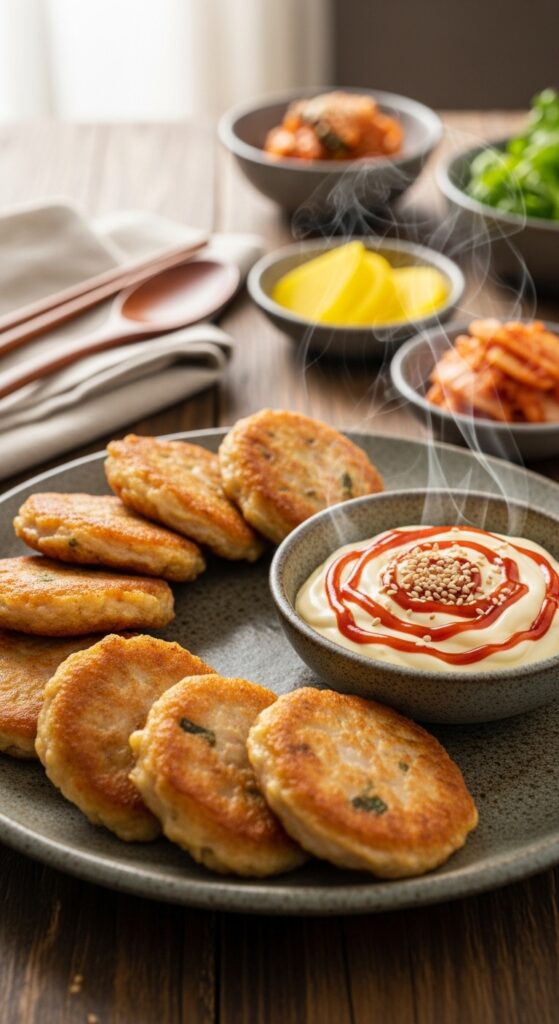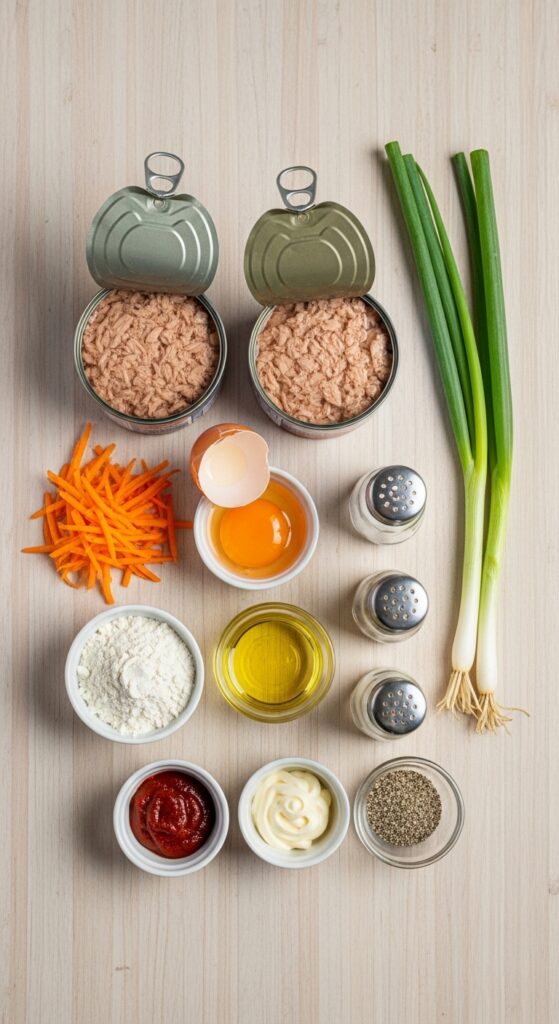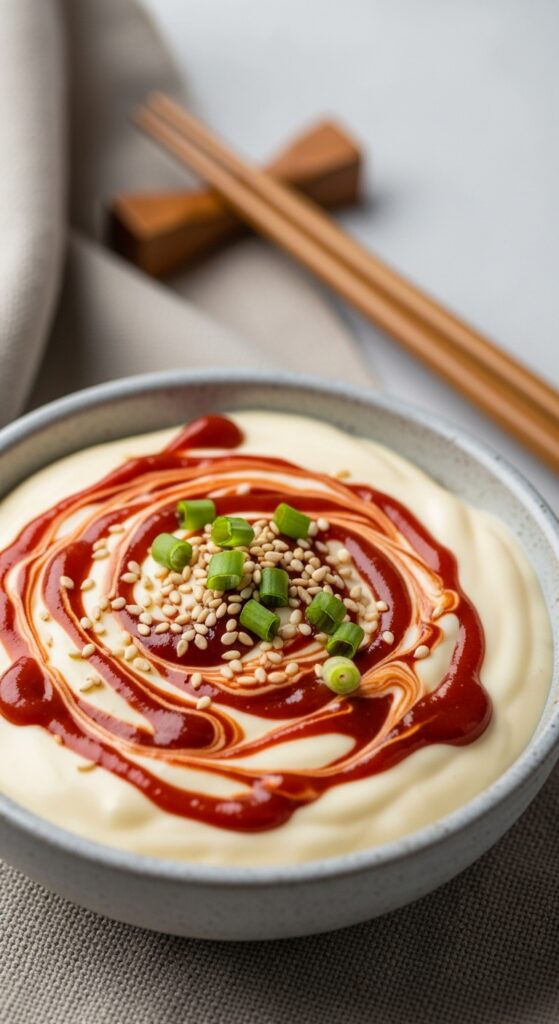Ever found yourself craving something crispy, savory, and just a little addictive—but not quite sure what to make? That’s where Tuna Jeon steps in. It’s one of those dishes that looks humble but delivers punchy flavor and pure comfort in every bite. Imagine golden-brown tuna patties sizzling in a pan, their edges crackling, the aroma of sesame oil filling the kitchen. Then, dip one into a creamy, tangy Korean mayonnaise sauce… and yeah, that’s when you know you’ve done something right.

Why It’s Special

Tuna Jeon isn’t fancy food—it’s home food. The kind that shows up in Korean lunchboxes, picnics, and on the side of steaming rice bowls. The word jeon (전) basically means “pan-fried savory pancake,” and it can be made with almost anything—zucchini, kimchi, meat, or in this case, tuna.
This version is especially beloved because it’s cheap, fast, and ridiculously satisfying. Canned tuna gets transformed into little golden fritters that taste way more luxurious than they have any right to. Plus, the creamy Korean mayo dip adds that signature Korean flair—just the right amount of spice, sweetness, and umami.
It’s the kind of snack your hands can’t stop reaching for. Perfect for late-night cravings, lunchbox side dishes, or as an appetizer that disappears before the main course even hits the table.
Ingredients & Substitutions

Let’s talk ingredients. You don’t need anything fancy, but small details make all the difference.
For the Tuna Jeon:
- Canned tuna – 2 cans (about 10 oz total). Tuna in oil gives richer flavor; tuna in water keeps it lighter.
- Eggs – 2 large, for binding and moisture.
- Flour – 3 tablespoons all-purpose flour. You can also use rice flour or potato starch for a lighter, crispier texture.
- Green onions – 2 stalks, finely chopped. They add a subtle sweetness and freshness.
- Carrot – 1 small, grated. Adds color, texture, and a touch of natural sweetness.
- Onion – ½ small, finely minced. Keeps the mix juicy.
- Salt & pepper – Just a pinch of each. Adjust after frying.
- Sesame oil – ½ teaspoon, for that signature nutty aroma.
For the Korean Mayonnaise Dip:
- Kewpie mayonnaise – 3 tablespoons. Creamier and more umami-rich than regular mayo.
- Gochujang (Korean chili paste) – 1 teaspoon. For that mild heat and subtle sweetness.
- Rice vinegar – ½ teaspoon, adds a bit of tang.
- Honey or sugar – ½ teaspoon, to balance out the spice.
- Garlic – ½ clove, finely grated. Adds a punch.
- Optional – Squeeze of lemon or a sprinkle of sesame seeds for extra flair.
Substitutions and Tips:
If you don’t have gochujang, mix sriracha with a tiny spoonful of miso paste—it’s a solid backup. For a gluten-free version, swap flour for potato starch. Want to go vegetarian? Mashed chickpeas or tofu can replace the tuna nicely, just season a bit more. And if you want a crispier crust, chill the mixture before frying—the cold batter hitting hot oil gives a better sear.
Step-by-Step Instructions

Making Tuna Jeon is wonderfully simple. The magic is all in the little details.
First, drain the tuna really well. Press it gently between paper towels to get rid of moisture. Too much liquid and your patties will fall apart.
Next, mix the base. In a large bowl, combine the tuna, eggs, flour, green onions, carrots, onions, sesame oil, salt, and pepper. Stir gently until the mix feels cohesive but not wet.
Now shape the jeon. Scoop a tablespoon of mixture and form small, flat patties—about two inches wide. They cook more evenly that way.
Preheat your pan on medium heat with a little neutral oil—canola or grapeseed works best. You want a soft sizzle when the patties hit the pan, not an angry splatter.
Cook in batches. Give each jeon about two to three minutes per side. Don’t overcrowd the pan or they’ll steam instead of crisp. Once both sides are beautifully golden, remove and rest them on paper towels or a wire rack. Let them breathe.
Pro tip: If you notice them darkening too quickly, lower the heat a bit. Perfect jeon are golden, not burnt.
Variations:
Feeling adventurous? Toss in some chopped chili for heat or a spoonful of gochugaru (Korean red pepper flakes). For a fun twist, fold in a bit of shredded mozzarella for a cheesy pull when you bite in. Or if you’re cooking vegan, go with mashed chickpeas or firm tofu and vegan mayo—the same crisp magic happens.
Cooking Techniques & Science

Let’s dive a little deeper. Why does Tuna Jeon get that incredible crisp outside but stay so tender inside? It’s all about the balance of protein and starch. The eggs act as binders, holding everything together, while the flour or starch creates that golden, crunchy crust when it meets hot oil.
The oil temperature is crucial. Around 325–350°F (160–175°C) is your sweet spot. Too hot, and they burn before cooking through; too cool, and they soak up grease. You can test it by dipping a chopstick—if small bubbles form around it, you’re ready.
The sesame oil is your aromatic ace. When it heats up, its nutty compounds bloom, giving your kitchen that comforting toasted smell that makes Korean cooking so irresistible.
As for the Korean mayo dip, it’s a game-changer. Kewpie mayo uses only egg yolks (no whites), which makes it extra smooth and rich. When mixed with gochujang, you get this bold, creamy sauce that hits every flavor note—sweet, spicy, tangy, umami. It’s the perfect contrast to the crisp jeon.
And yes, your pan matters. A well-seasoned cast iron or a good nonstick skillet distributes heat evenly and ensures that golden sear every single time.
👉 Recipe Card
Tuna Jeon with Korean Mayonnaise Dip
Prep Time: 15 minutes
Cook Time: 10 minutes
Total Time: 25 minutes
Servings: 3–4
Calories: ~210 per serving
Ingredients

For the Jeon:
- 2 cans tuna (10 oz total), drained
- 2 large eggs
- 3 tbsp flour (or potato starch)
- 2 green onions, chopped
- 1 small carrot, grated
- ½ small onion, minced
- ½ tsp sesame oil
- Salt & pepper to taste
- Oil for frying
For the Dip:
- 3 tbsp Kewpie mayonnaise
- 1 tsp gochujang
- ½ tsp rice vinegar
- ½ tsp honey
- ½ clove garlic, grated
- Optional: sesame seeds or lemon juice
Instructions
- Drain tuna well and press out extra moisture.
- Mix all jeon ingredients in a bowl until cohesive.
- Shape into small patties.
- Heat oil in pan over medium heat.
- Fry patties 2–3 minutes per side until golden.
- Mix dip ingredients in a small bowl.
- Serve hot with the dip on the side.
Serving & Pairing Suggestions

Tuna Jeon is incredibly versatile. It can play the role of a side dish, a snack, or even a light main. Serve it with warm rice and a few banchan (Korean side dishes) for a satisfying lunch.
For a party platter, arrange them neatly with the mayo dip in a small bowl in the center, sprinkle some sesame seeds, and maybe a few slivers of chili for color. It looks elegant but takes almost no effort.
Want to elevate it? Add a few microgreens or thin cucumber ribbons on top before serving. The freshness cuts through the richness perfectly.
To drink, nothing beats a cold beer or a lightly fizzy makgeolli (Korean rice wine). Both balance the oil and highlight the savory notes. Or keep it clean with a cup of cold barley tea or iced green tea—refreshing and simple.
Conclusion
Tuna Jeon with Korean Mayonnaise Dip is one of those humble dishes that makes you feel like a culinary genius. It’s quick, affordable, and ridiculously delicious. The key lies in texture—that perfect golden crust giving way to soft, flavorful tuna inside.
The creamy, spicy mayo dip ties it all together in one satisfying bite. It’s the kind of dish that feels special but requires almost nothing fancy.
So next time you spot a few cans of tuna in your pantry, don’t think of sandwiches—think jeon. Heat a pan, mix a few ingredients, and enjoy the smell of sesame oil and sizzling tuna filling your kitchen. Simple. Honest. Korean comfort food at its best.
FAQs
1. Can I make Tuna Jeon ahead of time?
Yes. Store them in the fridge for up to three days. Reheat in a skillet without oil to bring back the crisp texture.
2. What’s the best tuna to use?
Tuna in oil gives better flavor, but if you prefer something lighter, tuna in water works fine—just don’t forget that sesame oil for aroma.
3. Can I bake these instead of frying?
Absolutely. Bake at 400°F (200°C) for 12–15 minutes, flipping once halfway. They’ll be a little less crispy but still tasty.
4. Is there a non-spicy dip option?
Sure thing. Just skip the gochujang and add soy sauce, sugar, and a squeeze of lemon instead. It’s milder but still delicious.
5. Can I freeze Tuna Jeon?
Yes. Lay them flat on parchment, freeze until solid, then move to a freezer bag. Reheat straight from frozen in a skillet—they’ll crisp right up again.
Tuna Jeon isn’t just another snack—it’s a crispy, golden reminder that the simplest ingredients can make the most comforting food. Try it once, and it’ll become one of those recipes you just know by heart.

Selena is an experienced lifestyle blogger and the voice behind many of Cozy Toned’s inspiring posts. With a passion for mindful living, home styling, and everyday wellness, she shares practical tips and fresh ideas to help readers live beautifully and intentionally.